Eastern Gray Squirrel
- December 18, 2023
- 0 comment
The Eastern Gray Squirrel, scientifically known as Sciurus carolinensis, is a ubiquitous and adaptable mammal that has become a familiar sight in many parts of North America. Identified by its distinctive gray fur and a characteristic bushy tail, these squirrels play a significant role in the region’s ecosystems. However, their presence is not without conflicts, particularly in urban and suburban areas, where they often clash with humans over issues like property damage and bird feeder raids. The legal status of Eastern Gray Squirrels varies, with some regions considering them protected wildlife, while in others, they are viewed as a nuisance species.
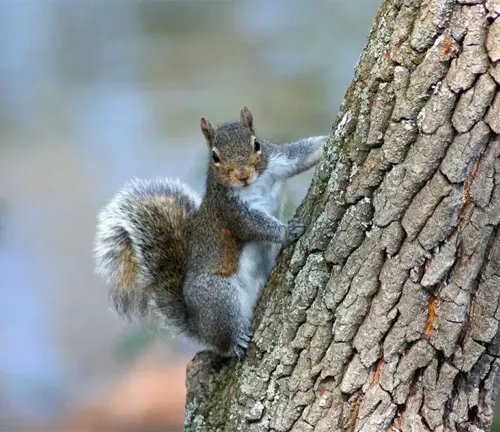

The species is easily recognizable, featuring a sleek, gray coat, although some individuals may exhibit reddish or brownish hues. The tail, an essential adaptation for balance, communication, and thermoregulation, is notably fluffy. Eastern Gray Squirrels boast a keen sense of curiosity and agility, allowing them to navigate trees and urban landscapes with ease. Their range spans from the eastern United States through parts of Canada, demonstrating a remarkable ability to thrive in diverse environments.
While these squirrels contribute positively to ecosystem dynamics, they also pose health and safety concerns. Their propensity for gnawing on electrical wires can lead to power outages and pose fire hazards. Additionally, Eastern Gray Squirrels can carry diseases, raising concerns about potential transmission to humans and other animals. As a result, managing human-wildlife conflicts and promoting coexistence requires a balanced approach that considers the ecological importance of these creatures while addressing the challenges they present to human communities.
| Category | Specification |
|---|---|
| Scientific Name | Sciurus carolinensis |
| Identification | Gray fur, with variations in reddish or brownish hues; bushy tail |
| Physical Description | Sleek, medium-sized body; average length of 18 inches, including a 9-inch tail |
| Range | Eastern United States, parts of Canada |
| Habitat | Varied, from forests to urban and suburban environments |
| Legal Status | Varies regionally; protected wildlife in some areas, considered a nuisance in others |
| Conflicts | Property damage, bird feeder raids, electrical wire gnawing |
| Health Concerns | Potential carriers of diseases; may pose safety risks |
| Adaptations | Agile climbers with a keen sense of balance and curiosity |
| Ecological Role | Plays a significant role in ecosystem dynamics |
Exploring the World of the Eastern Gray Squirrel
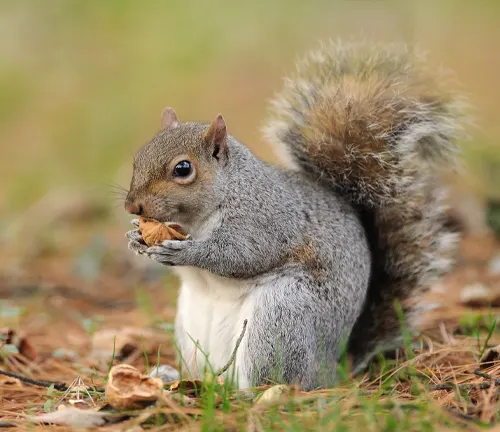
General Biology of the Eastern Gray Squirrel
The Eastern Gray Squirrel, scientifically known as Sciurus carolinensis, is a fascinating mammal that has adapted remarkably to various environments across the eastern United States and parts of Canada. With a sleek gray coat and a distinctive bushy tail, these creatures are not only a common sight but also play a crucial role in the ecosystems they inhabit.
Reproduction Habits
Reproduction is a key aspect of the Eastern Gray Squirrel’s life cycle. These agile creatures typically mate twice a year, in late winter and summer. Female squirrels construct nests called dreys, often high in trees, where they give birth to a litter of two to four young. The care and nurturing of the offspring involve a delicate balance between protection and independence, setting the stage for the next generation.
Behavioral Patterns
The behavior of Eastern Gray Squirrels is marked by their agile movements and keen curiosity. Known for their adaptability, these squirrels are equally at home in the dense forests as they are in urban landscapes. Their foraging habits and social interactions reveal a complex and intelligent species, capable of problem-solving and creative adaptation to changing environments.
Nesting and Denning Cover
Nesting is a critical aspect of the Eastern Gray Squirrel’s survival strategy. These creatures construct nests in tree branches, using a combination of twigs, leaves, and other materials. These dreys serve as shelter and protection, providing a safe haven for both rest and raising their young. Understanding their nesting behavior offers insights into their ability to navigate and thrive in various habitats.
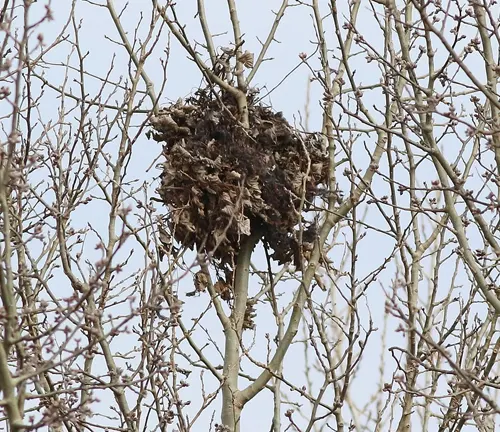
Habitat Preferences
Eastern Gray Squirrels exhibit a broad range of habitats, from deciduous and coniferous forests to urban and suburban areas. Their adaptability allows them to thrive in diverse ecosystems, making them a common presence in parks, gardens, and wooded areas. Observing their habitat preferences provides valuable information about the delicate balance between wildlife and human environments.
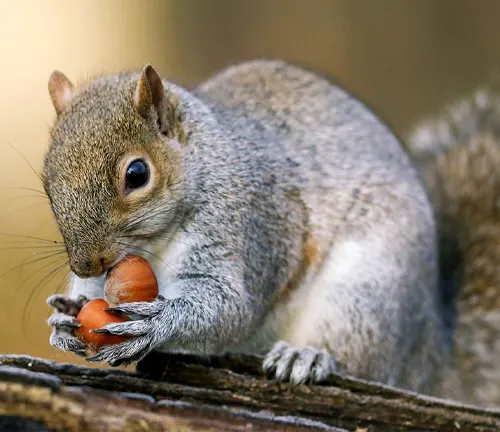
Food Habits and Foraging Techniques
These squirrels are omnivores with a varied diet that includes nuts, seeds, fruits, fungi, and even bird eggs. Their foraging techniques, marked by clever strategies and dexterous manipulation of objects, showcase their resourcefulness in obtaining sustenance. The seasonal variation in their food habits reflects a dynamic relationship with the changing landscape.
Voice, Sounds, Tracks, and Signs
The Eastern Gray Squirrel communicates through a combination of vocalisations, including chattering and high-pitched calls. Their vocal repertoire, coupled with body language, plays a crucial role in social interactions and signalling potential threats. Understanding their sounds, tracks, and signs enhances our ability to decode the intricate language of these creatures and offers a glimpse into their complex social structure.
Damage Identification by Eastern Gray Squirrels
Damage to Landscapes
The charming presence of Eastern Gray Squirrels in our surroundings often comes with a downside — damage to landscapes. These agile creatures, known for their tree-hopping antics, can wreak havoc on gardens and yards. From nibbling on flowers and shrubs to uprooting newly planted bulbs, their foraging habits can transform a carefully manicured landscape into a battleground between homeowners and their bushy-tailed visitors. Understanding the telltale signs of their presence is crucial for mitigating the impact on our outdoor spaces.

Damage to Crops and Livestock
As nature’s foragers, Eastern Gray Squirrels aren’t selective when it comes to satisfying their appetites. In rural areas, the impact extends beyond ornamental gardens to agricultural lands. Crops such as corn, sunflowers, and various fruits become susceptible to these squirrels’ relentless feeding habits. Additionally, the proximity of farmland to livestock can lead to indirect damage as squirrels disturb feed storage and inadvertently affect the well-being of domestic animals. Recognizing the signs of crop damage and implementing preventative measures are essential for maintaining a harmonious coexistence.

Damage to Structures
The charm of Eastern Gray Squirrels often fades when their activities take a toll on structures. Their relentless gnawing on wood, plastic, and even electrical wiring poses a significant threat to homes and buildings. Attics and crawl spaces become prime locations for nesting, leading to potential structural damage and fire hazards resulting from wire-chewing. Identifying signs of structural compromise, such as chewed insulation or droppings in overlooked corners, is crucial for homeowners seeking to address and prevent damage caused by these industrious squirrels.
Managing Eastern Gray Squirrel Damage with Prevention and Control
Habitat Modification
In the ongoing dance between humans and Eastern Gray Squirrels, one effective strategy for damage prevention involves habitat modification. By manipulating the environment to make it less appealing to these nimble foragers, homeowners and land managers can discourage destructive behaviours. This might include strategically placing bird feeders, securing trash bins, and minimising easy access to potential nesting sites. A thoughtful approach to habitat modification can create an environment that minimises the allure of our spaces to these resourceful squirrels.
Exclusion Techniques
Creating a barrier between Eastern Gray Squirrels and vulnerable areas is a fundamental aspect of damage control. Exclusion methods range from installing physical barriers like mesh screens on gardens or protective covers on crops to using specialised fencing to deter their entry into specific zones. Implementing exclusionary techniques requires a careful evaluation of the target area and a tailored approach to match the unique challenges posed by these persistent creatures.


Frightening Devices
Introducing elements of surprise can be an effective tool in the arsenal against Eastern Gray Squirrel damage. Frightening devices, such as motion-activated lights, ultrasonic deterrents, or even predator decoys, capitalise on the squirrels’ natural instincts to avoid potential threats. The key lies in the strategic placement and periodic rotation of these devices to maintain their effectiveness over time.
Repellents for Damage Prevention
The use of repellents is a common and humane method of discouraging Eastern Gray Squirrels from wreaking havoc on gardens and structures. From natural solutions like pepper-based sprays to commercially available repellent formulations, these substances create an unfavourable taste or odor that dissuades squirrels from exploring treated areas. Employing repellents demands a consistent and proactive application to ensure a reliable deterrent effect.
Toxicants: A Last Resort
While not the preferred method, toxicants can be employed as a last resort for severe infestations. The use of rodenticides, specifically designed for squirrels, should be approached with caution due to potential risks to non-target species and pets. Proper placement, adherence to guidelines, and compliance with local regulations are paramount when considering toxicants as a damage control measure.
Shooting as a Control Method
In certain situations, shooting may be considered as a control method, particularly in rural or agricultural settings where safety and legal considerations allow for this approach. This method requires precision and adherence to local firearm regulations. Before opting for this solution, it is essential to weigh the ethical, safety, and legal implications associated with the use of firearms for pest control.
Trapping Techniques
Trapping Eastern Gray Squirrels is a humane and targeted approach to managing their populations. Live traps can be employed to capture squirrels, allowing for their relocation to more suitable habitats. However, this method necessitates a responsible release site and compliance with local wildlife regulations. Trapping requires careful monitoring to avoid unintended consequences and ensure the well-being of both humans and squirrels.
Different Species
Fox Squirrel
(Sciurus niger)
Larger than the Eastern Gray Squirrel, the Fox Squirrel is recognised for its rusty-coloured fur and a distinctively bushy tail. They inhabit a variety of environments, including both urban and rural areas.
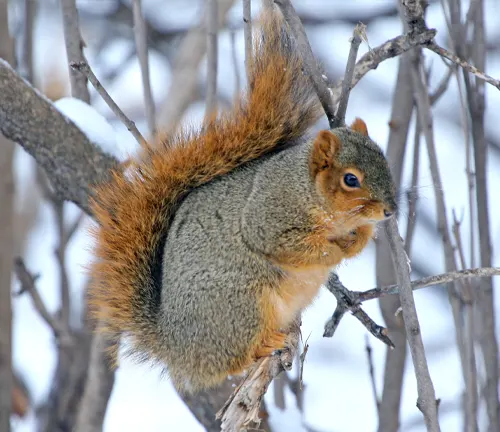

Red Squirrel
(Sciurus vulgaris)
Found in Europe and parts of Asia, the Red Squirrel is smaller than the Eastern Gray Squirrel and is characterised by its reddish-brown fur. They are arboreal creatures often associated with coniferous forests.
Western Gray Squirrel
(Sciurus griseus)
Inhabiting the western parts of North America, this species is larger than the Eastern Gray Squirrel and has a more limited range. It is often found in coniferous forests and oak woodlands.
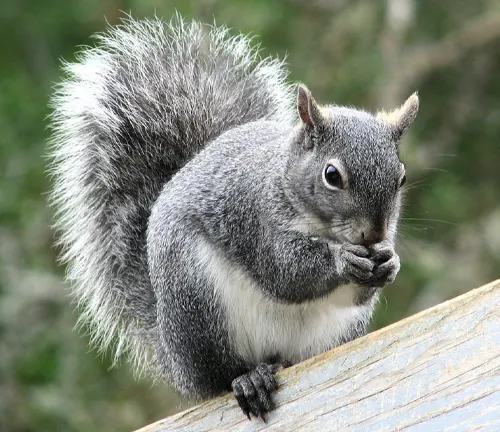

Southern Fox Squirrel
(Sciurus niger alleni)
This subspecies of the Fox Squirrel is found in the southeastern United States. It shares similarities with the Fox Squirrel but may have variations in fur color and markings.
Abert’s Squirrel
(Sciurus aberti)
Inhabiting the western United States, particularly in pine forests, Abert’s Squirrel has distinctive tufted ears and a grizzled gray coat. It is adapted to tree-dwelling and primarily feeds on pine cones.
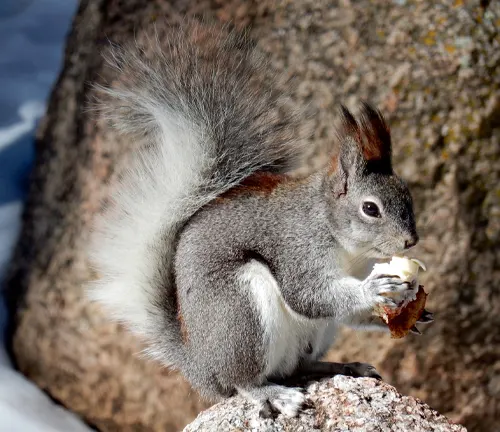
Frequently Asked Questions(FAQs)
1. What is the Eastern Gray Squirrel?
The Eastern Gray Squirrel (Sciurus carolinensis) is a medium-sized tree-dwelling rodent native to North America, known for its gray fur and bushy tail.
2. Where are Eastern Gray Squirrels found?
They are commonly found in the eastern United States and parts of Canada, thriving in various habitats, including urban areas, forests, and parks.
3. What do Eastern Gray Squirrels eat?
Eastern Gray Squirrels are omnivores with a varied diet that includes nuts, seeds, fruits, fungi, and even bird eggs.
4. How do they contribute to ecosystems?
astern Gray Squirrels play a role in seed dispersal by caching and forgetting nuts, contributing to forest regeneration. They also serve as prey for various predators.
5. Do they pose any risks or concerns?
Yes, they can cause damage to property, gardens, and structures through their gnawing habits. They may also carry diseases, and their population density can lead to conflicts with humans.
6. Are Eastern Gray Squirrels protected by law?
Legal status varies by region. In some areas, they are considered protected wildlife, while in others, they may be viewed as a nuisance species.
7. How do I prevent damage caused by Eastern Gray Squirrels?
Prevention methods include habitat modification, exclusion techniques, frightening devices, repellents, and, in extreme cases, the use of toxicants or trapping.
8. Are Eastern Gray Squirrels aggressive?
Generally, Eastern Gray Squirrels are not aggressive toward humans, but they may exhibit territorial behaviour, especially during mating seasons.
9. How can I distinguish Eastern Gray Squirrels from other squirrel species?
Eastern Gray Squirrels are identified by their gray fur, but it’s essential to note that there are other squirrel species with variations in colour, size, and markings.
10. What is their lifespan in the wild?
In the wild, Eastern Gray Squirrels typically have a lifespan of around 6 to 12 years, although many do not survive their first year due to predation and other factors.


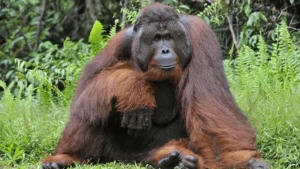


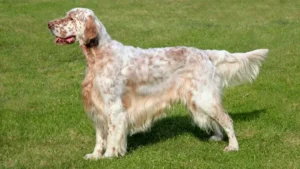
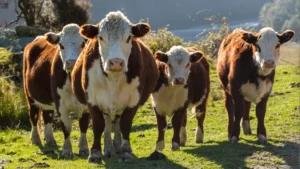
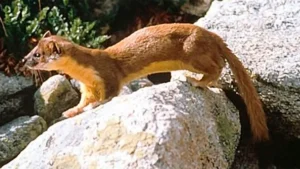


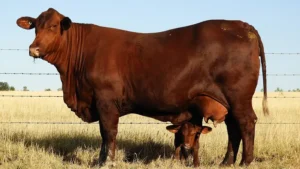
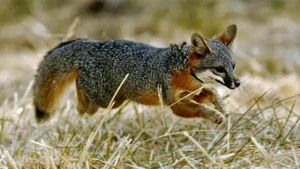


Leave your comment